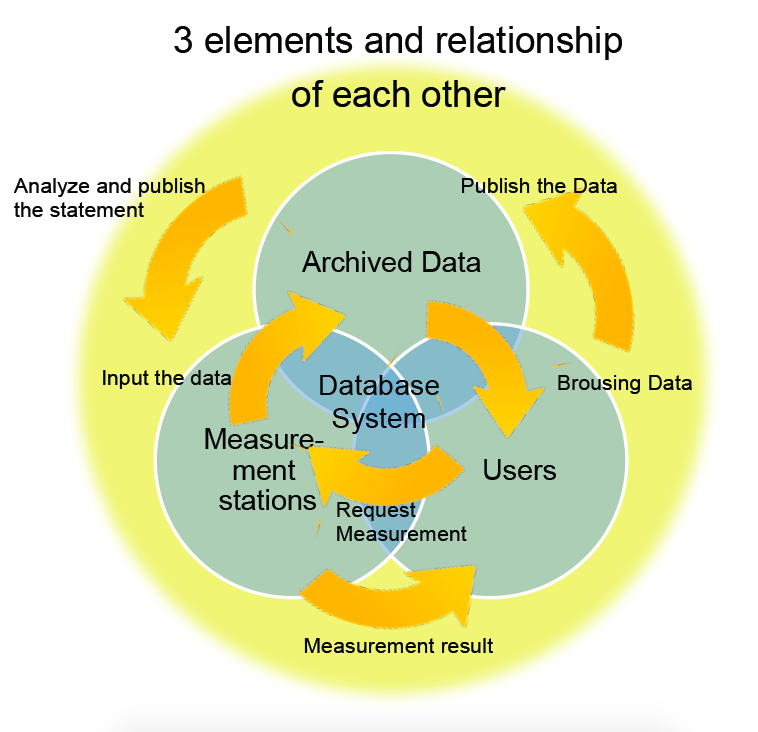What is "Minna-no Data Site"?
Everyone’s Data Site (Data Site) is a network of 30 citizens’ radioactivity measurement laboratories from all over Japan (as of July 2019).
After the 2011 Tokyo Electric Fukushima Dai-ichi Nuclear Power Plant accident, many independent citizen-operated radioactivity measurement laboratories sprang up across Japan.
In September 2013, a website called “Minna-no Data Site” was established in an effort to integrate all of the radioactivity measurement data into a common platform and disseminate accurate information in an easy-to-understand format.
As of July 2019, our website is home to approximately 16,000 cases of food measurement data, more than 3,400 cases of soil measurement data, and 1,700 cases of environmental samples (ash, river water, and etc...).
In 2018, the results of environmental samples such as ash and leaf mold were published on the Data Site website and the same year the results of the “Environmental Concentration Becquerel Measuring Project” (which identifies hotspot measurement data) were also made public on the website. Additionally, a section about basic information about radioactivity called “Learn” was also uploaded to our website. The goal of our website is to publish easy-to-understand data for everyone to have access to.
Measurement laboratories participating in Data Site continually carry out radioactivity measurements while regularly confirming the measurement accuracy of their measuring devices based on Data Site’s self-developed accuracy tests.
The administration of the network is carried out by a steering committee made up of members of the measurement laboratories and members of the Data Site secretariat.
Data Site is a non-profit volunteer group with no affiliation to political parties, social groups, or religious groups.
The Function of Data Site
Data Site has the following four major initiatives:
A. To collect and publicize radioactivity measurement data from the participating measurement laboratories
B. To improve the knowledge and measuring techniques of the participating measurement laboratories
C. To carry out our own analysis and survey research based on the collected data
D. To publish opinions based on the results of our survey research with the aim of influencing countermeasures and resolving problems related to radioactive contamination.
In order to make these initiatives sustainable we rely on continued measurement requests from citizens around the country.
Our History
2011: The Tokyo Electric Fukushima Dai-Ichi Nuclear Power Plant accident occurs and massive amounts of radioactive materials are emitted into the surrounding environment. After the accident, many grassroots radioactive measurement laboratories start springing up in various locations around Japan. Worried about their children’s health, many concerned citizens begin asking these laboratories to measure their food in an effort to detect radioactive contamination.
2012-2013: Various citizens’ groups come together and establish Data Site with the aim of collecting and making public the food measurement data compiled independently by each measurement laboratory. The goal is to construct a database and publish all of the data in the same format on a single website.
2014: In January, the “East Japan Soil Becquerel Measurement Project” (Soil Project) is conceived, and in October, with almost no budget in place, the project commences with fundraising and soil measurement activities taking place in tandem.
2017: In December, Data Site is awarded the grand prize of the “Hizumi Fund for Promotion of Information Distribution”. The awarding committee praised the citizens’ continuous efforts to transmit and distribute information and their efforts to visualize the problem of radioactivity.
2018: In November, Data Site self-published “Illustration: 17 Prefecture Radioactivity Map & Close Analysis” which showcases the results of the three-year-long “East Japan Soil Becquerel Measurement Project” and the results of the six-year-long food measurement analysis. The book also provides commentary and basic information about radioactivity.
2019: Translation of the above-mentioned book.
Our publishing company was awarded with the Japan Congress of Journalists Prize in July.

